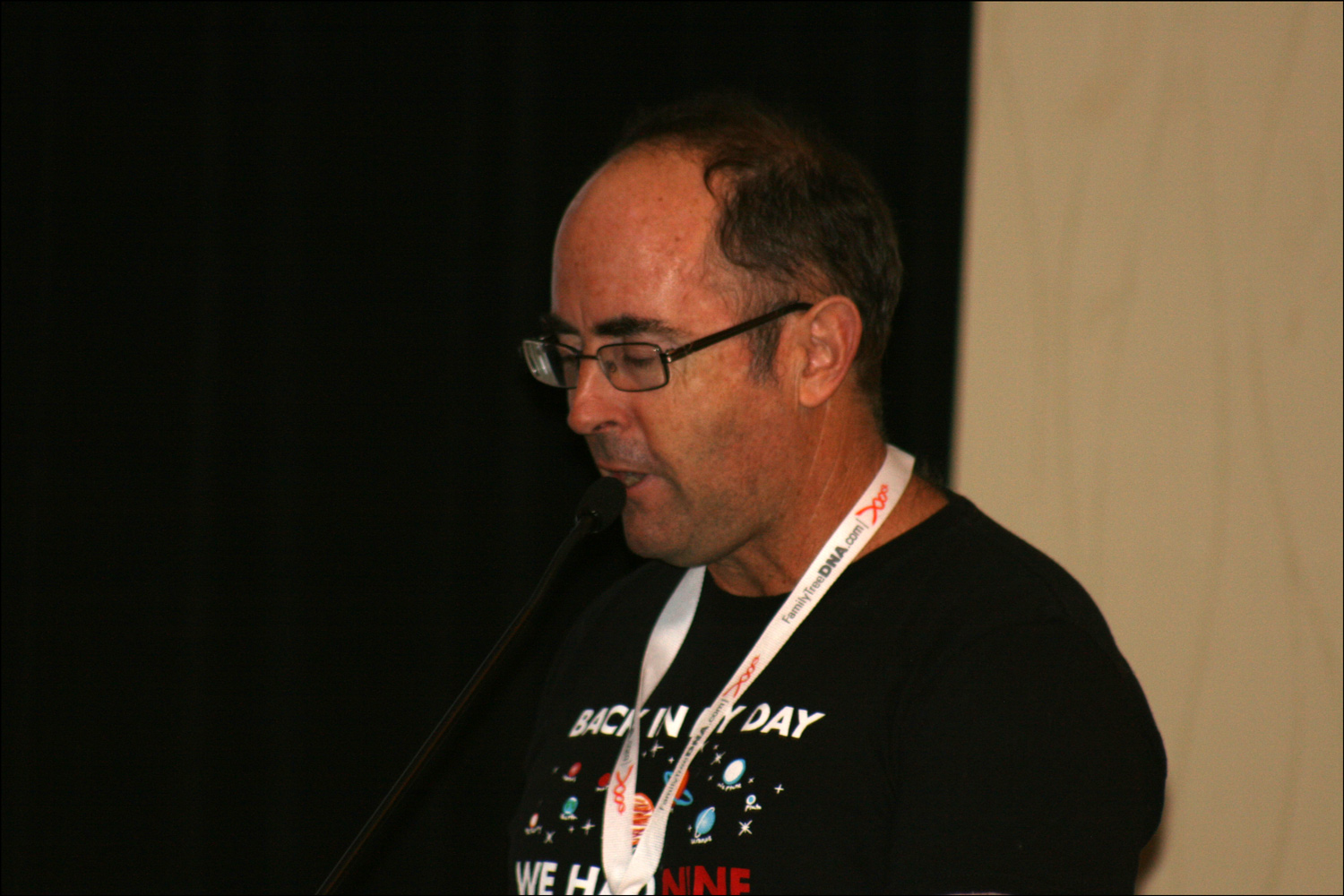At the Seventh International Family Tree DNA Conference for Group Administrators, Bruce Walsh, PhD presented a talk entitled “Genetic Genealogy Q&A”. I was particularly interested in this talk because, while I know quite a bit about Y-DNA and mitochondrial DNA (mtDNA), I am relatively new to Family Finder, Family Tree DNA’s version of autosomal DNA analysis.
Bruce Walsh
SOURCE: Bruce Walsh (Houston, Harris County, Texas); photographed by Stephen J. Danko on 05 November 2011.
Two random people differ at 20 million out of 3 billion bases in their DNA. The differences include short tandem repeats (STRs) which have many alleles (forms) and high mutation rates) and single nucleotide polymorphisms (SNPs) which typically have two alleles and low mutation rates.
Of the 46 chromosomes and mtDNA in humans, 44 chromosomes comprise the 22 pairs of autosomes, the X chromosome, the Y chromosome, and the mt chromosome. The Y chromosome and the mt chromosome are passed from generation to generation intact.
Because the Y chromosome and mt chromosome do not undergo recombination, they are useful for tracing the strict paternal ancestry (father’s father’s father, etc.) and strict maternal ancestry (mother’s mother’s mother, etc.) of an individual, but are not useful for following any other ancestral lines (such as mother’s father’s mother or father’s mother’s father). For these lines of ancestry that are not strictly paternal or maternal, one must analyze the inheritance of the 22 pairs of autosomes.
While the Y chromosome and the mt chromosome are passed from generation to generation intact, the autosomes are recombined or shuffled from one generation to the next. Unfortunately, because of recombination, if two people share a common ancestor, the autosomal DNA shared by those two people is less and less the farther back their common ancestor.
If two people are separated from their most recent common ancestor (MRCA) by one generation, the probability that those two people share at least one intact autosome is 0.99999976 (almost certain). If two people are separated from their MRCA by two generations, the probability is 0.947. If they are separated by three generations, the probability drops to 0.502. Four generations apart, and the probability is 0.158. Six generations, and the probability is 0.01068729. Seven generations, and the probability is only 0.00268211.
Because of recombination, the autosomes usually don’t get passed on to the next generation intact. So, as the autosomes are recombined, blocks of DNA, rather than intact autosomes, are passed on from one generation to the next.
TMRCA – Average Size of Block
1 – 44.06 cM
2 – 19.15 cM
3 – 12.30 cM
4 – 9.07 cM
5 – 7.19 cM
6 – 5.95 cM
7 – 5.08 cM
TMRCA = time to the most recent common ancestor (generations).
cM = centimorgan, a measure of distance in DNA corresponding to a 1% chance of recombination, or approximately 1 million DNA base pairs in humans.
When analyzing autosomal DNA results, the total amount of shared DNA allows an estimate of close relationships (1-3 generations). For more distantly related individuals, the size of the largest block of shared DN is used to estimate relationships.
Common blocks of DNA may be analyzed to determine whether the block of DNA is inherited from the father or the mother. This process is called phasing. The Y chromosome is inherently phased because it is inherited from the father. The X chromosome in males is also inherently phased because it must have been inherited from the mother.
Copyright © 2011 by Stephen J. Danko




